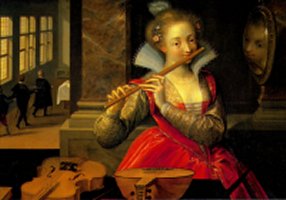
Hear the music of Shakespeare’s time in live performance as the Salish Sea Music Festival performs in Eastsound
From Jeffrey Cohan
Saturday, March 23 at 5 p.m. at the Adventist Fellowship Church, 107 Enchanted Forest Road, Eastsound
Not to be heard elsewhere! Experience a unique survey of the music of Shakespeare’s lifetime on period instruments at 5 PM on Saturday, March 23. It is serendipitous indeed that our program coincides with the Orcas Island’s Shakespeare Festival and we’ve adjusted our performance time in order that one might take advantage of all of the day’s activities.
Allow us to squash your preconceptions of renaissance music! This music exhibits great emotional depth in the context of today’s world, rhythmic complexity, and an unparalleled harmonic purity and power. We’ll introduce our tour of the “French” 4-part canzonas, composed in Italy only between 1582 and 1628, with two of the exquisite Franco-Flemish chansons which inspired them, published without text for instruments only a few years before in 1577. Then after an excursion across the channel through the music of Shakespeare’s England, we’ll end with examples of the “new” Italian style by Cima and Frescobali that emerged from these canzonas and morphed into Baroque music. Works to be performed include Ung Gay Bergier by Thomas Crecquillon and Petit Jacquet by Jean Curtois, Italian “French” canzonas by Maschera, Canale, Taeggio, Troilo, Cangiasi, Rivolta and Corradini, a Trio by Peter Philips and Fantasies by William Byrd, Alfonso Ferrabosco and John Ward, and finally in the “new” style, two canzonas by Girolamo Frescobaldi and a wonderful Sonata a 4 by Giovanni Paulo Cima in addition to his exquisite “O altitudo divitiarum.”
Our musicians are:
Jeffrey Cohan ~ renaissance flutes
Steve Creswell ~ viola
Courtney Kuroda ~ violin
Kyobi Hinami ~ harpsichord
Our program is of special significance for several reasons. It is precisely the music with with Shakespeare would have been familiar. Most of the program has not been heard for centuries, and we have made our own parts. It requires a tuning that is vastly less compromised and more powerful in many ways than has been true since, and it illuminates the transition at this very time between renaissance and baroque styles. The “French” canzonas arose exactly where and when the violin came to be appreciated as a solo instrument, in the area near Milan where so many famous violin makers were developing their craft. It marks the intimate connection between vocal and instrumental music in the renaissance, and the interweaving of influence between France and Italy. It illustrates how perfectly the renaissance transverse flute (quite a different creature from all flutes that came later) assumes the tenor role. And this music provides an ideal application of the “broken consort”: an instrumental ensemble composed of instruments from different families (in this case wind, string and plucked).
We hope to share Shakespeare’s “Most Heavenly Music” with you on Saturday in Eastsound!
Saturday, March 23 at 5 p.m. at the Adventist Fellowship Church at 107 Enchanted Forest Road in Eastsound · (360) 376-6683
The suggested donation is $15 or $20, and youth 18 and under are free.
For further information please see www.salishseafestival.org.
**If you are reading theOrcasonian for free, thank your fellow islanders. If you would like to support theOrcasonian CLICK HERE to set your modestly-priced, voluntary subscription. Otherwise, no worries; we’re happy to share with you.**







